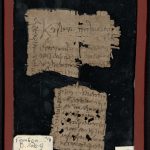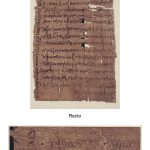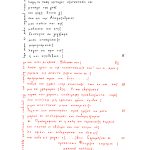| Artefact ID | 1683 |
| TM ID | TM 32838 |
| Findspot (DEChriM ID) | - () | Class | Textual |
| Material | Papyrus |
| Writing medium | Sheet/roll |
| Text content | Documentary |
| Language | Greek |
| Description | P. Ross. Georg. 5 6, P. Iand. 2 13, P.Iand.inv. 32: Letter from Eulogios to his son Philoxenos |
| Selection criteria | Christian terms/formulas/concepts, Nomina sacra |
| Date from | 300 |
| Date to | 425 |
| Dating criteria | Palaeography |
| Absolute/relative date | Relative date |
| Archaeological context | Unknown provenance (Oxyrhynchus?).
|
| Accession number | Tbilisi, Korneli Kekelidze Georgian National Centre of Manuscripts, No. 273; Giessen, Universitätsbibliothek P. Iand. 32. |
ARTEFACT IDENTIFIERS
Reference edition
• Zereteli, Gregor and Peter Jernstedt. 1935. Papyri Russischer und Georgischer Sammlungen (P. Ross.-Georg.) V. Varia. Tbilisi: Georgisches Museum. 23-30, No. 6.
Editio princeps
• Eisner, Leonhard. 1913. Papyri Iandanae. Fasciculus Secundus. Epistulae Privatae Graecae. Leipzig: Teubner. 51-54, No. 13. Tab. VI.
Additional bibliography
• Chepel, Elena. 2018. “P.Tbilisi inv. 344v: Extract from Memphite Land Register.” Tyche. Beiträge zur Alten Geschichte, Papyrologie und Epigraphik 33. 43-48: 44-45. [on Zereteli’s private collection]
• Choat, Malcolm. 2006. Belief and Cult in Fourth-Century Papyri. Studia Antiqua Australiensia 1. Turnhout: Brepols. 167. [listed]
• Hagedorn, Dieter. 1974. “O. Edfu 306 = Pack² 2447: Ein Privatbrief?” Zeitschrift für Papyrologie und Epigraphik (ZPE) 13. 110-111: 111. [on τάχιον]
• Horn, Robert Chisolm. 1926. The Use of the Subjunctive and Optative Moods in the Non-Literary Papyri [Diss.], Philadelphia. 154.
• Stanton, Greg R. 1988 “Τέκνον, παῖς and related words in Koine Greek.” In Proceedings of the XVIII International Congress of Papyrology. Athens 25–31 May 1986. Volume 1, edited by Basil G. Mandilaras. Athens: Greek Papyrological Society. 463-480: 463. [on τέκνον]
• Wilcken, Ulrich. 1913. “Papyrus-Urkunden.” Archiv für Papyrusforschung (AfP) 6. 268-301: 295.


 Json data
Json data





